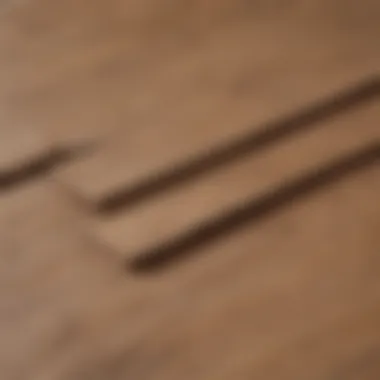Furniture Grips for Wood Floors: Stability & Protection


Intro
In the realm of interior design, the often-overlooked aspects of furniture placement can significantly influence both aesthetics and practicality. Among these are furniture grips for wood floors, which serve a dual purpose: ensuring stability and protecting the integrity of wood surfaces. Homeowners and renters alike face challenges when it comes to maintaining the beauty of their wood floors while maximizing the functionality of their furniture. This guide outlines essential insights about furniture grips, their various types, and the advantages they offer. Understanding these elements will empower individuals to make informed decisions that enhance their living spaces and maintain the elegance of wood flooring.
Design Inspiration
Current Interior Design Trends
To truly appreciate the value of furniture grips, it is essential to examine current trends in interior design. Minimalism remains a predominant theme. This aesthetic emphasizes clean lines, open spaces, and unobtrusive furniture. In such environments, the placement and stability of furniture become paramount. Grips not only stabilize but also contribute to a clean, organized look.
Natural materials often take center stage in modern design, with wood being a favored choice. Coupled with this trend is the tendency toward sustainable living, where every aspect of home décor is chosen with careful consideration. Therefore, grips that blend seamlessly with wood floors while providing robust support create a synergistic effect that appeals to environmentally conscious consumers.
Color Palettes and Their Effects
Color palettes directly affect the perception of space. Light colors tend to enhance feelings of spaciousness, while darker shades can add warmth and intimacy. Choosing furniture grips that match or complement the color of wood floors can enhance these effects. For instance, transparent grips might create an illusion of continuity between furniture and flooring, maintaining the elegant flow of the room.
Key Considerations:
- Light tones: Emphasize openness
- Dark tones: Contribute to warmth
- Contrasting colors: Can add visual interest if used thoughtfully
"The right color palette not only enhances the aesthetic appeal of a space but also subliminally communicates the intended mood."
As homeowners select hues and materials, they should reflect on how furniture grips integrate into this visual language.
Benefits of Furniture Grips
The benefits of furniture grips extend beyond mere aesthetics. They contribute significantly to the functionality of living spaces.
- Protection: Grips shield wood floors from scratches and dents caused by moving furniture. This preventative measure helps maintain the floor's condition over time.
- Stability: Some furniture, especially heavier pieces, benefit from grips that prevent them from sliding, reducing the risk of accidents or spills.
- Ease of Movement: Grips can facilitate the shifting of furniture without the heavy lifting, allowing homeowners to rearrange their spaces with minimal effort.
Types of Furniture Grips
There are several types of grips available, each with unique properties:
- Rubber Grips: Provide excellent traction and are ideal for heavier items.
- Felt Pads: Useful for lighter furniture, these help in gentle sliding and protection against scratches.
- Crochet Grips: These have a softer texture, suitable for delicate wood finishes.
- Vinyl Coated Grips: Wet resistant and durable, ideal for outdoor furniture on wooden decks.
Understanding the unique characteristics of these grips enables homeowners to choose the best fits for their furniture and flooring.
Installation and Maintenance Tips
Proper installation ensures maximum effectiveness. Most grips simply peel and stick, requiring minimal tools. It is, however, crucial to clean the flooring before application to ensure adhesion. Maintenance involves periodic checks to confirm the grips have not worn out. Regular cleaning of grips will prevent dirt accumulation, maintaining their efficacy.
Knowing these aspects of furniture grips can aid in making informed decisions that safeguard your investments. As homeowners emphasize thoughtful design, stability, and floor protection, the role of furniture grips will become increasingly indispensable in modern living environments.
Preface to Furniture Grips
Furniture grips serve a crucial role in the functionality and longevity of wood floors. For homeowners or even tenants, understanding these grips is not merely a matter of aesthetics; it is pivotal in protecting one's investment in flooring while enhancing everyday usability of furniture. Properly implemented grips can guard against the many factors that contribute to wear and tear on wooden surfaces. This means considering elements such as friction from movement, weight distribution, and environmental factors that may influence the integrity of the wood.
Definition of Furniture Grips
At their core, furniture grips are designed to limit movement and prevent sliding of furniture on wood floors. They are typically made from various materials, including rubber, cork, and felt, each having unique attributes that cater to different needs. The function of these grips ranges from simply stabilizing a piece of furniture to minimizing the risk of scratches and other damages. This protective mechanism becomes especially critical in high-traffic areas where furniture is frequently used or moved around.
In essence, furniture grips can be viewed as an essential accessory for any household with wood flooring. They provide not only practical solutions but also contribute to an organized and tidy appearance.


Importance of Floor Protection
Protecting wood floors is more than just a practice; it is essential for maintaining their beauty and value. Wood floors are vulnerable to scratches, dents, and other forms of damage that can arise from everyday use. When furniture shifts or slides, it can leave marks or even gouges that may require costly repairs or refinishing. The cumulative effects of such damages can have lasting repercussions on both the integrity of the flooring and the overall ambiance of a room.
Moreover, furniture grips play a significant role in enhancing safety within a living space. By securing furniture in place, they help reduce the risk of accidents, especially in homes with children or elderly residents. The emotional comfort that comes from knowing one's home environment is both beautiful and safe cannot be understated.
"Prevention is always better than cure. Investing in tools like furniture grips for your wood floors today can save you from more significant expenses later on."
Overall, the role of furniture grips merges function with aesthetics. They ultimately help uphold the high standards of care that wooden floors deserve while enhancing the usability of the furnishings upon them.
Types of Furniture Grips
Understanding the various types of furniture grips is essential for anyone seeking to protect wood floors effectively. Each type offers unique benefits and uses, ensuring stability while preventing damage. With several options available, selecting the right grip can significantly enhance your home’s aesthetics and functionality, making it important for homeowners and design enthusiasts to be well-informed.
Adhesive Grips
Adhesive grips provide a strong bond between the furniture and the floor. These grips typically feature a sticky backing that adheres directly to the furniture's legs. They are ideal for lightweight furniture, as they can effectively prevent movement and shifting. Installation is straightforward: simply peel off the protective layer and press the grip firmly onto the furniture leg. Thin profiles enable a seamless look, making them less noticeable.
However, it is crucial to ensure that adhesive grips are suitable for the floor type. On polished wood surfaces, adhesive can sometimes leave residue, requiring careful consideration before application. Periodic inspections should be done to ensure they remain effective over time.
Non-Slip Pads
Non-slip pads are designed to reduce movement significantly. These pads often come in various materials and are suitable for both light and heavy furniture. They can be placed on the bottom of chairs, tables, or sofas to prevent them from sliding on wooden floors. Often made from rubber or a similar material, they provide optimal grip.
Because of their versatile nature, non-slip pads offer ease of installation and maintenance. They can be removed and cleaned, ensuring that they maintain their effectiveness over time. However, attention is required to the condition and wear of the pads. Any sign of degradation warrants replacement to continue providing protection.
Rubber Feet
Rubber feet serve as an excellent choice for heavy furniture. Their sturdiness provides an effective barrier against sliding, ensuring that items like sofa sets, cabinets, and dining tables remain stable. These grips typically have a textured surface that increases friction with the floor, offering a reliable hold.
Installation is similar to adhesive grips, but rubber feet often involve a screw or bolt mechanism. This method can provide a more secure attachment to the furniture. As with any product, it is essential to check compatibility with wooden floors, as some rubber compounds can discolor or damage the surface over time.
Cork Pads
Cork pads are an eco-friendly choice that balances performance with sustainability. Natural cork material provides a soft surface that protects wood floors from scratches while also offering excellent grip. They are suitable for various furniture types, especially where gentle support is needed.
One of the unique aspects of cork pads is their ability to compress under weight. This characteristic adds a layer of shock absorption, which can be particularly beneficial for heavy items. Installation is quite simple; just peel off the backing and stick them to the furniture leg. Regular cleaning will enhance their lifespan considerably.
Felt Pads
Felt pads are known for their ability to minimize scratches effectively and reduce noise. These pads absorb shock and noise, making them particularly valuable for homes with wooden floors. Felt is often softer than other materials, thereby providing a cushioned surface for furniture legs.
They are available in various sizes, allowing for customization according to furniture dimensions. Easy to install, felt pads can often just be stuck to the bottom of furniture legs. However, they might require more frequent replacement than harder materials due to wear and tear, especially in high-traffic areas.
In summary, understanding the different types of furniture grips can aid in making an informed decision to protect wood floors. Selecting the right grip not only enhances stability but also ensures the longevity of your furniture and flooring.
Benefits of Using Furniture Grips
Understanding the benefits of using furniture grips is crucial for anyone looking to maintain the integrity of wood floors while enhancing the stability and appeal of their furniture. Furniture grips serve multiple functions, each playing a vital role in protecting your floors and furniture while improving the overall aesthetic of your space. Below we delve into the specific benefits that these grips provide, shedding light on how they can contribute positively to your living environment.
Protection Against Scratches
One of the primary functions of furniture grips is to provide protection against scratches. Wood floors can be easily marred by the movement of heavy furniture. Without adequate protection, a simple rearrangement can lead to unsightly scratches and damage. The materials used in furniture grips, such as felt or rubber, create a buffer between the furniture legs and the floor surface. This minimizes direct contact, thus significantly lowering the risk of scratches. Over time, even minor scratches can accumulate, detracting from the beauty of your wooden floors. Therefore, investing in furniture grips not only protects against immediate damage but preserves the long-term aesthetics of your home.


Enhanced Furniture Stability
Another significant benefit of using furniture grips is the enhancement of furniture stability. Slippery or uneven floors can cause furniture to wobble, leading to discomfort and hazardous situations. Furniture grips, especially those designed with non-slip materials, increase the grip of furniture legs on the floor. This creates a more stable seating or surface arrangement, ensuring that items do not slide out of position during use. Moreover, stable furniture can reduce the wear and tear of the furniture itself, as it does not undergo unnecessary shifts that could cause structural damage over time.
Noise Reduction
Noise can be a substantial disturbance in a household, especially in open-concept designs or shared living spaces. When furniture moves across hard floors, it often creates loud scraping sounds that can be disruptive. Furniture grips contribute to noise reduction by softening the impact of furniture movement. For example, felt pads can absorb sound and prevent clattering noises when chairs are moved. This improvement in acoustics can enhance the overall comfort of your living space, making it more inviting and pleasant for both residents and guests.
Ease of Movement
Another practical advantage of furniture grips is that they allow for easier movement of furniture. Whether rearranging for a gathering or cleaning, grips facilitate the smooth movement of furniture pieces across the floor. In addition, certain types of grips can make sliding heavy items less strenuous. This ease of movement not only simplifies cleaning tasks but also allows homeowners to adjust their space without requiring unnecessary effort. Even for those who might struggle with mobility, such grips can significantly enhance the usability of their surroundings.
Aesthetic Appeal
Lastly, furniture grips contribute to the overall aesthetic appeal of a room. With various options available, such as clear rubber grips or stylish felt pads, homeowners can choose grips that complement their existing decor. The right choice of grips can enhance furniture appearance while serving functional purposes. For example, cork pads not only provide protection but also integrate a natural look that suits many interior design styles. The combination of practicality and aesthetics ensures that your space remains inviting and stylish while safeguarding your wood floors.
Selecting the Right Furniture Grips
Choosing the appropriate furniture grips is crucial for protecting wood floors while ensuring furniture stability. High-quality grips can prevent movement, minimize scratches, and enhance the aesthetics of a space. It is important to evaluate various factors when selecting grips to tailor them for specific needs.
Considerations for Different Wood Types
Wood floors come in various types, each with unique characteristics that can influence grip effectiveness. For instance, softer woods like pine are more susceptible to scratches than harder woods such as oak or maple. When selecting grips, consider how the grip material interacts with the wood's surface. Soft pads like felt can help protect softer woods from scratches, while more durable materials like rubber can provide stability without damaging harder surfaces. Matching the grip to the wood type ensures longevity for both the floor and the furniture.
Weight Capacity of Grips
Furniture grips vary widely in their weight-bearing capabilities. Understanding the weight of your furniture is essential when selecting grips. Each grip type has a specified weight limit, and exceeding this can lead to failure, resulting in damage not only to the furniture but also to the floor. It's advisable to check manufacturer guidelines to ensure that the grips chosen can accommodate the weight of your furniture. Ensuring proper weight capacity is important in maintaining structural integrity.
Compatibility with Furniture Materials
Furniture is made from different materials, such as metal, wood, or plastic. Each material reacts differently with grip products. For instance, plastic furniture may require grips that adhere strongly, while wooden furniture can benefit from softer pads that reduce friction. Selecting grips that are compatible with furniture materials helps prevent wear and can improve stability. Additionally, some grips may adhere better to certain materials, enhancing overall effectiveness.
Environmental Considerations
Environmental factors should not be overlooked when selecting furniture grips. Some grip materials may not be suitable for high-humidity areas or extreme temperature environments. For instance, outdoor furniture grips should be weather-resistant. Furthermore, consider the environmental impact of the materials used in the grips. Eco-friendly materials such as cork may be preferred by environmentally conscious consumers. Evaluating the environmental impact helps create a sustainable living space.
Installation of Furniture Grips
Installing furniture grips is a critical aspect of maintaining the integrity of wood floors. Without proper installation, grips may fail to deliver the protection and stability they promise. This section will explore the necessary tools, provide a step-by-step installation guide, and highlight common mistakes to avoid during the process.
Tools Required
Before starting the installation of furniture grips, gather all the necessary tools. Having the right tools can simplify the process and enhance your results. Common tools used include:
- Measuring tape: For precise measurements of furniture legs.
- Ruler or straight edge: To assist in marking exact placements.
- Cleaning cloth: Ensures the surfaces are free of dust and debris.
- Pencil: To mark positions before adhering grips.
- Utility knife: If trimming grips is needed for a better fit.
- Adhesive: In case you're using adhesive grips, ensure it is compatible with both grips and furniture material.
Step-by-Step Installation Process
Correctly installing furniture grips requires attention to detail. Follow these steps for an effective installation:
- Clean the Surface: Use a cleaning cloth to remove dirt and grease from the furniture legs. A clean surface is crucial for ensuring good adhesion.
- Measure and Mark: Use the measuring tape and pencil to mark where the grips will be placed on the furniture legs. Precision is key to achieve even placement.
- Cut Grips if Necessary: If any grips require customization, use a utility knife to trim them to the needed size. Ensure the cuts are clean to avoid jagged edges.
- Apply the Grips: For adhesive grips, remove the backing and firmly press them onto the marked area. Make sure to apply even pressure to ensure they adhere properly. For non-adhesive types, simply place them at the bottom of the legs.
- Allow for Cure Time: If adhesives were used, give them the proper amount of time to cure as stated on the packaging before moving the furniture back into place.
- Test Stability: Once everything is set, gently test the furniture to ensure the grips are holding and providing the necessary stability.
Common Mistakes to Avoid


To ensure successful installation, be aware of these frequent pitfalls:
- Neglecting to Clean: Skipping the cleaning step can hinder the grip's effectiveness.
- Incorrect Measurements: Not measuring accurately can lead to grips that do not fit well.
- Forgetting to Allow Cure Time: Moving furniture before the adhesive has set can lead to grip failure.
- Ignoring Material Compatibility: Not considering the furniture material might result in using the wrong type of grip.
By following these guidelines, homeowners can confidently install furniture grips that protect their wood floors while maintaining a stable and attractive living space.
Maintaining Furniture Grips
Maintaining furniture grips is crucial for ensuring their effectiveness and longevity. Grips provide not only stability but also protection against potential damage to wood floors. These grips can wear down or lose their functionality over time due to regular use. Therefore, understanding how to properly maintain them is essential for both functionality and aesthetics.
Regular Inspection
Regular inspection of furniture grips is a recommended practice. Homeowners should check the grips for wear and tear every few months. Look for signs of damage, such as peeling or cracking of materials. If any grips are dislodged or if the adhesive begins to weaken, it may lead to instability or scratches on the floor. An early inspection can prevent larger issues that can arise from neglected grips. Keeping a schedule for inspection can also aid in maintaining an overall tidy and safe home environment.
Cleaning Techniques
Cleaning furniture grips should be undertaken with care. Use a soft cloth to remove dust and debris regularly. For sticky residue, gentle soap mixed with warm water is effective. Avoid harsh chemicals that can damage the material of the grips. After cleaning, ensure they are completely dry before reattaching to furniture. This simple maintenance step can help prolong the life of the grips, contributing to better functionality.
Replacement Guidelines
Knowing when and how to replace furniture grips is part of effective maintenance. Grips should be replaced if they show significant wear or when they no longer adhere properly. A good guideline is to consider replacement every 6 to 12 months, depending on usage levels. When selecting new grips, ensure to choose ones that match the weight capacity and type of furniture. Accurate replacement will help maintain stability and protect the flooring from inevitable wear.
"Regular maintenance of furniture grips not only preserves your wood floors but also enhances your overall living experience."
By consistently inspecting, cleaning, and replacing grips as needed, homeowners can protect their investments and enhance the safety and stability of their living spaces.
Removing Furniture Grips
Removing furniture grips is a crucial process that many homeowners overlook. The act of removing these grips should not be taken lightly, as improper removal can potentially lead to damage to both the furniture and the floor. Understanding the right techniques and necessary precautions can ensure a hassle-free removal process without compromising the integrity of the wood flooring.
Safe Removal Techniques
When it comes to safely removing furniture grips, a few important steps can make the process easier and safer. Firstly, assess the type of grip used. For instance, adhesive grips often require a different method of removal compared to rubber or felt pads. If the grip is an adhesive one, heat can be used to soften the glue, making it simpler to peel away. A hairdryer or heat gun set on low can work well for this. Be sure to hold it at a safe distance to avoid overheating the surface.
Another effective method is to use a plastic scraper. This will help gently lift the grip without scratching or damaging the wood underneath. Start from one edge and gradually work your way to the center. It is also advisable to apply a small amount of adhesive remover if residue is left behind, always ensuring it is safe for wood surfaces. After removing the grip, it's important to clean the area thoroughly to prevent any buildup of glue or dirt.
Potential Damage During Removal
Awareness of potential damage is essential when removing furniture grips. Improper techniques can lead to scratches, dents, or even finish removal from the wood floor. If too much force is applied while scraping, there is a risk of harming the wood. Additionally, if adhesive removers are used that are too harsh, they might strip away the finish or stain of the wood.
It's also possible for underlying surfaces to be affected. For example, if grips are not handled carefully, they might tear off pieces of the floor finish or even get stuck in vinyl flooring. It is wise to work slowly and steadily, ensuring you are not rushing the process. Always take the time to evaluate the tools being used and the specific type of grip being removed to minimize risk.
Removing furniture grips correctly is vital to preserving both the furnishings and the flooring beneath them. A careful approach can save homeowners from costly repairs and maintain the aesthetic appeal of their spaces.
Culmination
In this section, we will underscore the importance of utilizing furniture grips for wood floors, an essential consideration for maintaining both the aesthetic and functional aspects of a home.
Summarizing the Importance of Grips
Furniture grips serve as a protective measure that benefits both the furniture and the flooring underneath. They prevent scratches, dents, and other forms of damage that can result from the normal movements of furniture items. By ensuring that furniture remains stable, grips also contribute to the safety of residents, reducing the risk of accidents caused by shifting furniture. It is crucial for homeowners to recognize that investing in quality furniture grips is not just about preservation; it is a step towards maintaining the overall integrity of their living space.
Final Thoughts on Selection and Maintenance
Selecting the right furniture grips involves consideration of several factors, including the type of flooring, the furniture’s weight, and the materials of both the grip and the furniture itself. Regular maintenance includes checking grips for wear and cleaning them to maintain their effectiveness. Being diligent in these areas ensures that the grips continue to perform well over time. A thoughtful approach to both selection and maintenance reinforces the value and longevity of a home’s interior, aligning with the broader goals of style and protection for wood floors.
"Investing in furniture grips is a proactive approach to floor care that pays dividends in protection and aesthetic value."
Ultimately, understanding furniture grips creates a more informed homeowner, capable of making decisions that protect their wood floors while enhancing the living environment.















